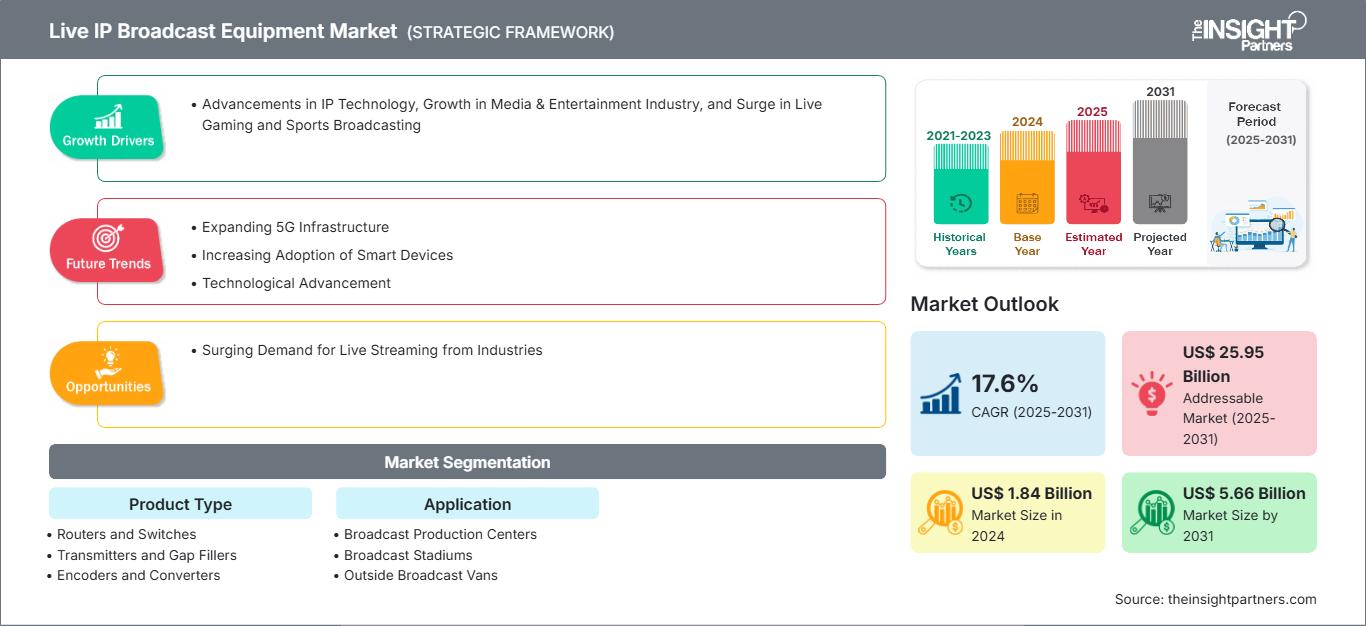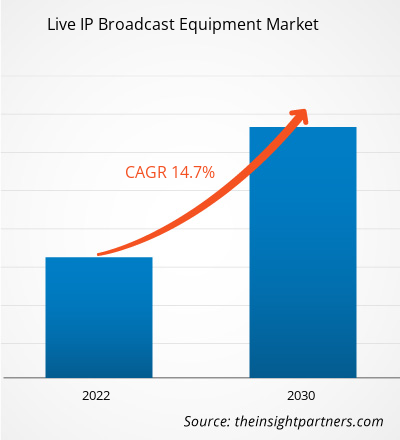The live IP broadcast equipment market size was valued at US$ 1.84 billion in 2024 and is expected to reach US$ 5.66 billion by 2031; it is estimated to register a CAGR of 17.6% during 2025–2031. Surging demand for live streaming from industries is likely to bring future market trends.
Live IP Broadcast Equipment Market Analysis
Content produced in 4K and ultrahigh-definition (UHD) formats requires transmission in a similar format for enhanced viewing quality, which requires effective IP live-production technology. Media and entertainment industries are growing rapidly, contributing to the live IP broadcasting equipment market growth. Incorporating innovative technologies in the digital media industry is a trend in live-streaming media businesses. Organizations are focusing on digital technologies to build a brand and showcase new products for manufacturing low-cost hardware intended for the broadcaster, with live streaming at the forefront.
Live IP Broadcast Equipment Market Overview
Live IP broadcast equipment captures, processes, and transmits live audio and video content over internet-based networks, rather than traditional broadcasting infrastructure such as satellite or coaxial systems. The shift to IP (Internet Protocol) allows broadcasters and content creators to produce and distribute live video with greater flexibility, scalability, and often at lower costs. Increasing demand for direct-to-consumer (D2C) products via OTT services and multichannel networks, digitalization, ongoing investments in R&D operations for the development of new manufacturing systems, and rising IT spending bolster the demand. The market growth is driven by advancements in IP technology, the proliferation of the media and entertainment industry, and a surge in live gaming and sports broadcasting. Technological advancements and equipment modernization, expanding 5G infrastructure, increasing adoption of smart devices, and burgeoning demand for live-streaming channels are expected to benefit the companies operating in the live IP broadcasting equipment market in the future.
Customize This Report To Suit Your Requirement
You will get customization on any report - free of charge - including parts of this report, or country-level analysis, Excel Data pack, as well as avail great offers and discounts for start-ups & universities
Live IP Broadcast Equipment Market: Strategic Insights

-
Get Top Key Market Trends of this report.This FREE sample will include data analysis, ranging from market trends to estimates and forecasts.
Live IP Broadcast Equipment Market Drivers and Opportunities
Growth in the Media and Entertainment Industry
According to a CII GT report, India's Animation and VFX industry is expected to expand from US$ 1.3 billion in 2023 to US$ 2.2 billion by 2026, resulting in an increase in its contribution to the Media and Entertainment (M&E) sector from 5% to 6%. According to the International Trade Administration (ITA), in 2024, the US M&E industry valued US$ 649 billion (of the US$ 2.8 trillion worldwide market). In 2023, foreign direct investment totaled US$35.2 billion in the motion picture and sound recording industry, and $8.9 billion in the radio and cable broadcasting industry. According to a CII GT report, India’s Animation and VFX sector is expected to expand from US$ 1.3 billion in 2023 to US$ 2.2 billion by 2026, increasing its contribution to the M&E industry from 5% to 6%. Data from YouTube revealed that watch time for live streams had increased by 250%. As per Stream Hatchet’s 2024 “Live Streaming Trends Report,” live streaming reported a 12% year-over-year increase in hours watched, reaching a total of 32.5 billion hours.
The demand for affordable and flexible solutions for remote contribution, live streaming, IP-based production, and AV-over-IP is increasing. The rising demand for ultra-high definition (UHD) content, the alteration to cloud-based products, solutions, apps, and open architecture, investments in high-speed broadband infrastructure, demand for multi-screen video consumption, and developments in over-the-top (OTT) services fuel market growth. In May 2022, Sony Sports Network announced in India that Roland-Garros 2022, the second Grand Slam event, to be aired in four regional languages for live broadcast. The tournament was streamed on Sony Sports Network’s on-demand OTT platform, SonyLIV. In mid-March 2020, Google reported a 300–500% increase in searches for live-streaming platforms.
Technological Advancements and Increasing Demand for Live-Streaming Channels
There is a growing requirement to optimize network bandwidth and expand the consumer base for live streaming content. In April 2023, Google announced that bring together over 800 live streaming channels, including NBC, CBS, ABC, and Fox, into a novel guide in the Google TV interface. Organizations focus on digital technologies to build a brand and showcase new products for manufacturing low-cost hardware intended for the broadcaster, with live streaming at the forefront. In 2021, Innovative Systems, Inc. (US) partnered with Midwest Video Solutions (US) to provide a fully hosted end‐to‐end streaming video service. In 2021, FilmMyMatch (US) entered into an agreement with JOYMO (Norway) to provide live streaming, video management, and production services to customers across the UK. According to the Vedico, more than 70% of Gen Z consumers show a clear preference for live content over traditional television, driven by their desire for authentic experiences and real-time engagement. In January 2025, Comcast introduced Sports & News TV, a new video offering for Xfinity Internet subscribers that consolidates live news coverage, premier sporting events from the NFL, NBA, NHL, MLB, and NCAA, along with popular movies, TV shows, and primetime programming into a single, comprehensive package. Thus, ongoing technological advancements and increasing demand for live-streaming channels are expected to provide future growth opportunities for the live IP broadcasting equipment market.
Live IP Broadcast Equipment Market Report Segmentation Analysis
Key segments that contributed to the derivation of the live IP broadcast equipment market analysis are product type and application.
- Based on product type, the live IP broadcasting equipment market is segmented into transmitters and gap fillers, encoders and converters, amplifiers, antennas, modulators and repeaters, routers and switches, video servers, IP Synchronization Equipment, PTP Servers, and others. The routers and switches segment dominated the market in 2024.
- Based on application, the live IP broadcasting equipment market is segmented into broadcast stadiums, outside broadcast vans, and broadcast production centers. The broadcast production centers segment dominated the market in 2024.
Live IP Broadcast Equipment Market Share Analysis by Geography
- The live IP broadcast equipment market is segmented into five major regions: North America, Europe, Asia Pacific (APAC), the Middle East & Africa (MEA), and South & Central America. Asia Pacific dominated the live IP broadcast equipment market in 2024. North America is the second-largest contributor to the global live IP broadcast equipment market, followed by Europe.
- The live IP broadcast equipment market in North America is segmented into the US, Canada, and Mexico. These countries are known as early adopters of digital technologies worldwide. In the region, Netflix, Amazon Prime Video, Disney+, and Paramount+ provide a diverse portfolio of content offerings, encompassing live sports, feature films, television series, and exclusive original productions. News networks are expanding their presence across OTT platforms, enabling audiences to access live broadcasts and on-demand news content with greater flexibility. The global Media & Entertainment (M&E) Team of the ITA has export offices in over 100 US cities and at 80 embassies, supporting the M&E industry along with its clients with licensing and trade services to expand in international markets. The team helps enterprises from this industry expand their digital media, M&E production, live video games and e-sports, streaming, television, or broadcast segments. A robust M&E industry in the US supports the growth of this industry in Canada and Mexico with the help of the US–Canada–Mexico trade agreement. According to the ITA, in 2024, the US Media and Entertainment (M&E) industry stood at US$ 649 billion (of the US$ 2.8 trillion worldwide market).
The regional trends and factors influencing the Live IP Broadcast Equipment Market throughout the forecast period have been thoroughly explained by the analysts at The Insight Partners. This section also discusses Live IP Broadcast Equipment Market segments and geography across North America, Europe, Asia Pacific, Middle East and Africa, and South and Central America.
Live IP Broadcast Equipment Market Report Scope
| Report Attribute | Details |
|---|---|
| Market size in 2024 | US$ 1.84 Billion |
| Market Size by 2031 | US$ 5.66 Billion |
| Global CAGR (2025 - 2031) | 17.6% |
| Historical Data | 2021-2023 |
| Forecast period | 2025-2031 |
| Segments Covered |
By Product Type
|
| Regions and Countries Covered |
North America
|
| Market leaders and key company profiles |
|
Live IP Broadcast Equipment Market Players Density: Understanding Its Impact on Business Dynamics
The Live IP Broadcast Equipment Market is growing rapidly, driven by increasing end-user demand due to factors such as evolving consumer preferences, technological advancements, and greater awareness of the product's benefits. As demand rises, businesses are expanding their offerings, innovating to meet consumer needs, and capitalizing on emerging trends, which further fuels market growth.

- Get the Live IP Broadcast Equipment Market top key players overview
Live IP Broadcast Equipment Market News and Recent Developments
The live IP broadcast equipment market is evaluated by gathering qualitative and quantitative data post primary and secondary research, which includes important corporate publications, association data, and databases. Key developments in the live IP broadcast equipment market are listed below:
- Belden acquired Voleatech for €5.0 million (US$ 5.6 million), net of cash acquired. The acquisition includes a potential earn-out up to €3.0 million based on certain targets over three years, which will be accounted for as compensation cost. Voleatech, based in Germany, is known for its VT AIR Next Gen Firewall and expands Belden's Firewall product portfolio and overall planning of security in OT networking. Voleatech is reported within the Automation Solutions segment.
(Source: Belden, Press Release, September 2024)
- Grass Valley, a provider of live production solutions, announced that Scandinavian remote video production powerhouse DMC Production (DMC) revolutionized its live coverage of the 2024 RallyX, leveraging Grass Valley AMPP to live stream the exciting motorsports races and championship via YouTube with exceptional quality.
(Source: Grass Valley, Press Release, June 2024)
Live IP Broadcast Equipment Market Report Coverage and Deliverables
The "Live IP Broadcast Equipment Market Size and Forecast (2021–2031)" provides a detailed analysis of the market covering the areas mentioned below:
- Live IP broadcast equipment market size and forecast at global, regional, and country levels for all the key market segments covered under the scope
- Live IP broadcast equipment market trends, as well as market dynamics such as drivers, restraints, and key opportunities
- Detailed PEST and SWOT analysis
- Live IP broadcast equipment market analysis covering key market trends, global and regional framework, major players, regulations, and recent market developments
- Industry landscape and competition analysis covering market concentration, heat map analysis, prominent players, and recent developments for the live IP broadcast equipment market
- Detailed company profiles
Frequently Asked Questions
What are the driving factors impacting the live IP broadcasting equipment market?
What are the future trends of the live IP broadcasting equipment market?
Which are the key players holding the major market share of live IP broadcasting equipment market?
Which is the fastest growing region market?
Which Region is holding the major market share of live IP broadcasting equipment market?
What is the estimated global market size for the live IP broadcasting equipment market in 2024?
- Historical Analysis (2 Years), Base Year, Forecast (7 Years) with CAGR
- PEST and SWOT Analysis
- Market Size Value / Volume - Global, Regional, Country
- Industry and Competitive Landscape
- Excel Dataset
Recent Reports
Related Reports
Testimonials
Reason to Buy
- Informed Decision-Making
- Understanding Market Dynamics
- Competitive Analysis
- Identifying Emerging Markets
- Customer Insights
- Market Forecasts
- Risk Mitigation
- Boosting Operational Efficiency
- Strategic Planning
- Investment Justification
- Tracking Industry Innovations
- Aligning with Regulatory Trends





















 Get Free Sample For
Get Free Sample For